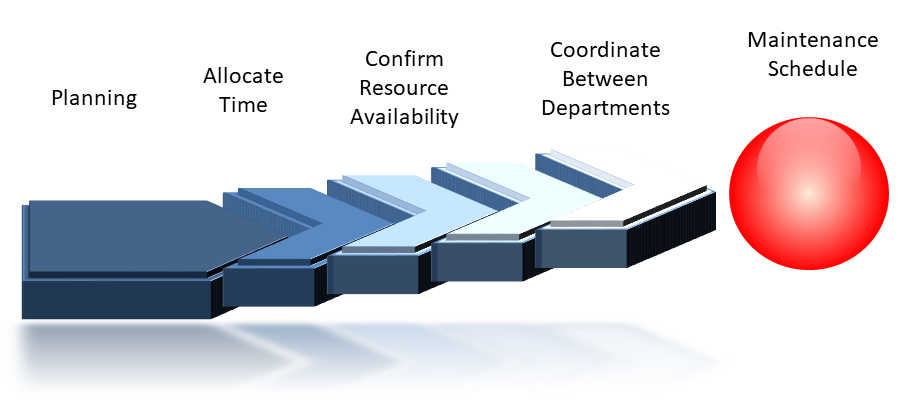Maintenance Planning is all about delivering safer and more cost effective work plans. Done properly, it can dramatically increase the amount of work achievable, without increasing the number of people. But what is Maintenance Scheduling? More to the point, what is the difference between Maintenance Planning and Scheduling?
Note: This post may contain affiliate links. Please read our disclosure policy for more information.
Maintenance Planning
We have discussed the definition and benefits of Maintenance Planning in detail in a previous article. Essentially it is an end to end process which includes the following:
- Planning the scope
- Learning from the job
- Recording historical data.
- When done properly, Planning can increase wrench time, thus increasing maintenance effectiveness.
Maintenance Scheduling Definition
The Business Dictionary definition for Scheduled Maintenance is:
A level of maintenance that requires planning, allocation of significant amount of time, and high degree of coordination between departments, and is typically initiated through a work order.
Let’s break this down further.
Scheduling Requires Planning
Maintenance Planning is the predecessor of Scheduled Maintenance. Maintenance Planning and Scheduling are both predecessors of Planned Maintenance Execution.
Significant Amount of Time for Scheduling
Scheduling is all about time. Firstly, it requires detailed information about the time required to perform the job. Secondly, it requires knowledge of when the job can be done. Thirdly, it allocates a significant amount of work to be done on a nominated day.
Scheduling Coordinates between Departments
In order to establish when the job can be done, it is often necessary to coordinate between different departments. Here are a few examples:
- Supply of resources. When are the parts, equipment and people available?
- When does the customer require the work to be carried out? What is the priority of the work?
- What is the availability of the asset. When is access available for the work to be carried out?
What Does a Maintenance Scheduler Do?
Maintenance Schedulers are responsible for identifying who will actually perform the work. To do this they need to know the availability of the people who will perform the work.
The Maintenance Scheduler must figure out when the job will be done. To do this they need to find out the availability of the specific equipment or area. Also the availability of the tools and materials required to perform the work.
Once who and when is figure out for the job, the Maintenance Scheduler compiles this into a list of many jobs, to produce a list of scheduled maintenance. This is then presented to the equipment or process owner for approval prior to any work being carried out.
Planning and Scheduling are Different
So as you can see Planning and Scheduling are different. Planning determines What, How and why the work is to be carried out. Scheduling determines who and when the work is to be carried out. Together Maintenance Planning and Scheduling form the maintenance schedule, or maintenance program.
Bringing It All Together
So scheduling requires a great deal of coordinating and organizing to bring the maintenance program together. It requires coordination of a great deal of information, people, materials, equipment and other resources to complete the work.
Successful scheduling requires a good understanding of the job plan, a good relationship with the plant owner, and detailed coordination of all the resources to get the job done.
Preventive Maintenance Schedule
Another important function of maintenance scheduling is to manage the preventive maintenance schedule. This is normally generated automatically by the CMMS, based on the maintenance plans carefully built by the planner or reliability engineer. A key function of the scheduler is to ensure that the maintenance program includes the preventive maintenance schedule, and that the work is achievable with the allocated manpower.
Backlog Management
The scheduler is responsible for managing the backlog of outstanding work.
Producing Weekly Work Schedules
Normally work is scheduled by using weekly schedules. These are often referred to as short term schedules. As against medium term schedules may cover a period of 3-12 months, and Long Term schedules may cover 1 or more years.
2 necessary inputs in to weekly work schedules are the available labor hours, and the scheduled labor hours. The schedule must be achievable, having sufficient available labor hours to carry out the work. This is referred to as schedule loading, the scheduled / available hours. 80-90% schedule loading is typical, with some allowance for unplanned work, delays, absenteeism etc.
Weekly Scheduling Meetings
The scheduler normally runs a weekly scheduling meeting, where all stakeholders in the schedule are present. The asset owners or operations are present to commit to release plant or equipment when required. Maintenance is present to commit to doing the work at the agreed time.
Scheduling Tools
Back in the day scheduling may have been successfully done using a simple scheduler board on the wall. These days Maintenance scheduler software is the norm. It may be as simple as using the CMMS to export a list of jobs into a spreadsheet, and then manipulate the spreadsheet into a final schedule.
These days many CMMS programs come with their own scheduling tools to allow real time updating on a scheduling board. This can be graphical scheduling, dragging and dropping jobs on the screen with the ability to update work order information as you go.
Often a bolt on front end is used to integrate into the CMMS to provide a live scheduling board on the computer, integrating directly to the CMMS. Scheduling can be done in real time, directly interfacing and updating the CMMS.
In large and complex assets separate scheduling software may be required. This may or may not interface with the CMMS. Very large schedules can be managed in this manner, and Primavera and MS Project are 2 examples. Often interface programs exist to link between the scheduling software and the CMMS, although it may not be real time updating.
Benefits of Maintenance Scheduling
When it comes to benefits, maintenance planning and scheduling work hand in hand. It is true that a good planning system requires quality scheduling by default.
The benefits of good planning are improved wrench time, increased maintenance efficiency, and cheaper, safer work plans.
The benefits of scheduling are quite similar to planning:
Improved wrench time:
Because the scheduler has obtained prior approval by the asset owner and maintenance, all the key stakeholders are ready and waiting on the day the job is to be done. That means minimum time wasted due to waiting for access to the asset, and hence improved wrench time.
Increased Maintenance efficiency:
Improved wrench time naturally translates to improved efficiency, and vice versa. Efficiency is improved because the job is well planned, all the resources are available, both maintenance and operations are prepared, and the job is primed to be done in the minimum amount of time possible. Also it is possible to secure the best possible deal on all resources with the benefit of time on your side.
Cheaper and Safer Work Plans
Whilst it is the planning that identifies specific job requirements related to resources and materials, it is the scheduling which coordinates this between all relevant parties. It is the coordination, the organization and the communication of the maintenance scheduling which brings it all together in a cheaper, safer manner.
Scheduled Maintenance Examples:
1. Plant Air Compressor Fault
Background:
During a routine Condition Monitoring Work Order to carry out Vibration Monitoring on a compressor, it was observed that the motor bearings were failing. The cause is premature bearing roller failure. The report gave a time period of 3 months to replace the bearings before predicted failure.
Planning
The Maintenance Planner was responsible for planning the work to be done. Tasks done by the planner:
- Located the correct parts on the Bill of Materials and allocated them to the Work Order.
- Allocated the correct number and type of maintenance technicians to carry out the work.
- Estimated the job duration based on personal experience and previous job history.
- Coded the work order as ‘Planning Complete and ‘Awaiting Parts’
Scheduling
After planning is completed the scheduler takes over:
- Checked the priority of the job, and the due by date.
- Checked the availability of parts.
- Noticing that the job is ‘awaiting parts’, monitors the job until the parts were safely delivered on site. Then the scheduler updates the Work Order code to ‘Parts Available’.
- Discussed with the Operations department when the job can be carried out. Operations advised that no opportunity is available for over 12 months without loss of production, unless a backup air compressor is provided.
- Organize back up air compressor and agree on maintenance schedule with Operations.
- Obtain final commitment the week before the job is to be done by both operations and maintenance in the scheduling meeting.
2. Pump Overhaul
Background
One of the tailings pumps requires an overhaul of wet end wear components, at the end of their useable life due to wear.
Maintenance Planning
Because this is a cyclical wear related failure, it can be predicted and automated. The planner can set this up as a Preventive Maintenance task.
- Analyze historical wear related wet end replacements, determine the Mean Time between Failure.
- Set up a standard job with all the resources assigned to the job. This includes manpower, equipment and materials. It also included estimates of job duration.
- Automate the job using the CMMS, so that a work order will be automatically generated. This particular job will generate after 2,600 hours of running time for the pump.
Maintenance Scheduling
- Monitor the simulated Preventive Maintenance Schedule of future work and check material availability. If materials are not available then take steps to expedite to meet required date. Once it is established that materials are available, code Work Order as ‘materials available’
- Allocate labor and equipment resources to perform the work. This is done using the CMMS scheduling module.
- Check with Operations that this equipment will be available on the required date.
- Present the job in the Weekly Scheduling Meeting such that both Operations and maintenance commit to carrying out the work on the agreed date.
Learn More about Shutdown Maintenance
There are no secrets to success. It is the result of preparation, hard work, and learning from failure. – Colin Powell
Learning from text books is one key step to enduring success. Here is some recommended reading to help you in your pursuit of excellence.
Would you like a free copy of 7 Steps to Become a KPI Ninja?
Not sure how to set up your Maintenance KPI’s? We have created the 7 Steps to Become a KPI Ninja guide to help you build, analyse and improve your KPI’s. It contains details of all the best metrics to measure, and how to interpret them. And we want you to have it for FREE.





